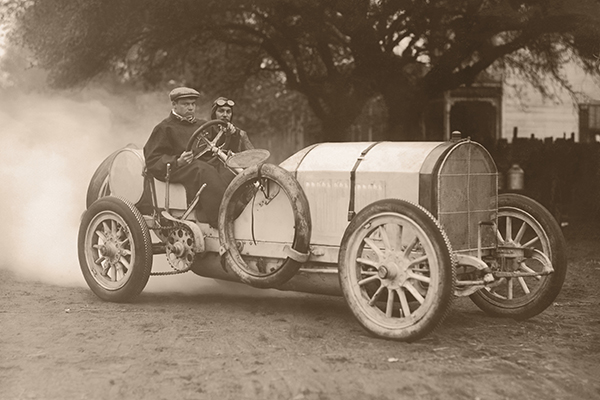The Evolution of Cars and Consumer Expectations

Article Highlights:
- See how far the automotive industry has come.
- Understand changing consumer expectations and how to meet them.
Have you ever thought about how far the automotive industry has come since the creation of the first car? From three-wheeled cars to punch-inducing Volkswagen Beetles to battery-powered rovers that live on the moon, join me as we look back at the evolution of the industry and look ahead at what’s on the horizon.
1886
Karl Benz introduced the first practical vehicle powered by an internal combustion engine. He created the three-wheeled Motor Car known as the Motorwagen, the first car to go into production. To advance the automotive industry, he worked tirelessly to create this car. His wife was an avid supporter, even showcasing the vehicle by driving fifty miles to her hometown with their two sons. Because of the Benz family and their relentlessness to propel forward, we can conveniently travel by car anywhere we want. The opportunity to buy a Motorwagen was few and far between, with only about 25 built between 1886 and 1893. The progress we have made since the 1800s is remarkable.
1900
At the beginning of the 20th century, Ferdinand Porsche built the first hybrid car, with a battery-powered wheel hub powering the back wheels and a gasoline engine powering the front wheels. A model like this would cost you a pretty penny. Ranging from $3,000-7,000 doesn’t seem too bad compared to prices today, but this equates to $91,000-$216,000 in today’s dollars. Imagine paying that much to go ten mph in an open-concept car!
Around this time, dedicated car dealerships were born too. They provided a reliable distribution network for manufacturers and made the car purchasing process much more convenient for consumers.
1938
We have Mr. Porsche to thank for our sore arms after passing by a Punch buggy. Yes, Porsche engineered the Volkswagen Beetle. It was introduced the year before WWII, and there were over twenty million assembled before production ended in 2003.
During this time, The Great Depression hit America hard, and automotive groups were no exception. General Motors offered unbelievable discounts on their high-end cars to help consumers with less money buy a car at an affordable price. When the economy shifted, GM continued to lower prices so that people who were struggling financially could still afford to buy a car.
1971
The first lunar rover makes its debut on the moon. Whoever said vehicles are only earth-bound can kick (moon) rocks. These rovers could reach 11.2 mph, pacing faster than the first-ever motor vehicles. The designers of this vehicle made sure to keep things practical by allowing the rover to fold and store for the trip to the moon. Imagine folding up your car and taking it to space with you. By doing this great feat, NASA astronauts were able to defy all odds and show that traveling on the moon was possible.
During this time, significant changes were not limited to outer space. The prominent manufacturers in the US were Ford, General Motors, and Chrysler, but the market saw foreign brands such as Toyota and Honda investing in the US, giving consumers more options beyond the big three. This also meant more franchises were available to car dealers.
1997
That brings me to the next invention: the Toyota Prius. The Prius was the first mass-produced hybrid model to hit the market. The Japan-based model may not be the most attractive car, but it certainly gained appeal as gas prices continued to rise. The Prius was so affordable that Toyota lost money on every model sold.
Outside of physical vehicle change and advancements, the automotive tech space grew considerably too. At the turn of the 21st century, Autotrader introduced car buyers to the online vehicle marketplace, and we haven’t looked back. Having access to a dealership’s inventory on desktops created an opportunity for consumers to browse online and research vehicles they were interested in without stepping foot into a brick-and-mortar store. This changed the game forever and no longer required consumers to spend their Saturdays going to dealerships.
Present Day
Over the last century and a half, the automotive industry has made great strides in providing consumers with a vehicle that will fit their needs. It all started with a single clunky, hard-to-obtain car, which has evolved into 100s of vehicle makes and models ranging from diesel engines to electric, and the industry continues to exceed expectations with new advancements every day.
Not only have vehicles evolved, but so has the way we buy cars. Over the last few years, a blended retailing experience has become incredibly popular with the convenience and control it offers consumers. More people are opting to complete parts of the car buying process online, and 58% of consumers are willing to pay more for a vehicle if signing paperwork is offered virtually. By providing certain parts of the buying process online, you can ensure your dealership is doing its part to meet buyers’ expectations. This can lead to increased CSI and sales, benefiting both parties.
With consumer expectations always changing, it’s important to embrace change and meet their needs. Everyone has different preferences when looking to buy a car. To appeal to every customer, consider offering a hybrid approach in your dealership. Through the hybrid approach, you can appease all types of buyers by providing a blend of human interaction and online retailing. Make sure to do your part to accommodate consumer expectations, just like the industry has been doing for years.
Resources:
History of the Invention of Cars- Hawley
Gamechanger: How Ferdinand Porsche Designed the First Hybrid Car- Porsche
Fifty Years Ago the First of the Three Lunar Roving Vehicles Took on the Ultimate Road Trip- Strohl
Data and Trends: United States Car Imports-Samuels
Toyota Prius Model Timeline-Toyota of Melbourne
The History of Car Sales- Whisbi
Automotive Digital Retailing: Modern Dealership Solutions- Williams
Related Articles:

The Future is Here, and It’s Powered by AI
The world changed forever in 1983. Most people weren’t ready for the internet revolution. In 2025, we’re on the brink of another technological revolution.

NADA 2025: Working in a Winter Wonderland
This year's show proved that the auto industry can handle anything. If you couldn't make it, find out what happened in the Reynolds booth.

NADA… the Catalyst for 2025: What’s Ahead for Reynolds
With the NADA show now behind us, take a peek at where Reynolds is headed this year.

Why Your Data Is Wickedly Underutilized
In today’s digital world, your data is your most valuable factor for success, especially your first-party data. But the thing is, there’s potential for it…















